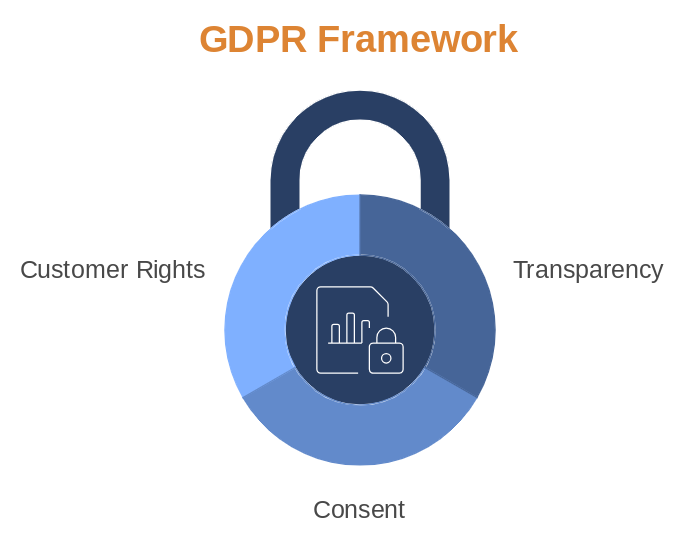In today’s digital-first world, personalisation is no longer optional—it’s expected. But with growing concerns over data privacy and the stringent requirements of regulations of General Data Protection Regulation (GDPR) , small businesses face a unique challenge. How can you deliver tailored customer experiences without crossing the line on privacy? That’s exactly what we’ll explore in this post. From understanding key legal requirements to implementing actionable strategies, you’ll gain expert insights to navigate the privacy-first personalisation landscape with confidence.
Understanding Key Regulations
GDPR: Transparency, Consent, and Data Rights
GDPR, enacted by the European Union, sets the gold standard for data privacy. It emphasizes transparency, requiring businesses to clearly communicate how customer data is collected, stored, and used. Consent is another cornerstone—customers must actively agree to data collection, and businesses must honor their rights to access, delete, or transfer their data. Non-compliance isn’t just a legal risk; it’s a trust issue in the eyes of your customers.
CCPA: Empowering Consumer Control
For U.S.-based businesses, the CCPA is a game-changer. This California law gives consumers the right to know what data is collected about them, the right to delete it, and the right to opt out of its sale. Even if your business isn’t based in California, the CCPA’s influence is shaping broader data privacy expectations. Ignoring it could mean alienating a significant portion of your audience.
Strategies for Privacy-First Personalisation
1. Use Customer-Provided Data
One of the most effective ways to personalise while respecting privacy is to use zero-party data—information customers willingly provide. This could include preferences shared through surveys, feedback forms, or account settings. Not only does this method ensure compliance, but it also builds trust by giving customers control over the data they share.
Pro Tip: Create a preference center on your website where customers can update their interests and communication preferences. Transparency is key!
2. Focus on First-Party Data
First-party data—information collected directly from your website, email campaigns, or CRM—is a goldmine for personalisation. Unlike third-party data, which often raises privacy concerns, first-party data is both compliant and reliable. For example, tracking which products a customer views or adds to their cart can help you tailor recommendations without stepping on any legal toes.
“First-party data is not just a compliance strategy; it’s a trust-building opportunity.” – Jane Huggins, Data Privacy Expert
3. Personalise in Real-Time
Real-time personalisation doesn’t have to rely on invasive profiling. Instead, use anonymised data and machine learning to adapt to a customer’s immediate behavior. For instance, if a user lingers on a specific product page, you could display a pop-up with a discount code for that item. This approach respects privacy while enhancing the customer experience.
4. Secure and Manage Data Effectively
Data security is non-negotiable. Implement measures like encryption, two-factor authentication, and regular security audits to protect customer information. Establish clear data governance policies that outline who has access to data and how it’s used. Remember, a data breach can undo years of trust-building in an instant.
5. Empower Customers with Control
Customers are more likely to trust businesses that give them control over their data. Offer easy-to-use tools for opting out of data sharing, accessing their information, or deleting their accounts. Clearly communicate your data practices in plain language—ditch the legal jargon.
Example: Patagonia’s privacy policy is a great example of transparency. They use simple language to explain how customer data is handled.
Choosing the Right Tools and Partners
Selecting the right technology is critical for privacy-first personalisation. Look for tools that prioritize compliance, such as privacy-focused analytics platforms or consent management software. Evaluate third-party vendors to ensure they meet GDPR and CCPA standards. Remember, your partners’ non-compliance could become your liability.
For a list of recommended tools, check out our Privacy Tools for Small Businesses guide.
Legal and Ethical Considerations
While legal compliance is essential, ethical data practices go a step further in building customer loyalty. Always ask yourself: “Would I be comfortable if this data practice were publicized?” Ethical behavior isn’t just good for your conscience; it’s good for business.
Statistic: A 2022 survey by Cisco found that 86% of consumers care about data privacy, and 79% are willing to take action to protect their data, such as switching providers.
Best Practices for Implementation
- Be transparent about how and why you collect data.
- Always obtain explicit consent for data collection.
- Engage customers by asking for their preferences and respecting their choices.
Future Trends and Predictions
The privacy landscape is evolving rapidly. As new regulations emerge and consumer expectations grow, businesses must stay agile. Expect to see increased demand for data transparency tools and a greater emphasis on ethical data practices. By adopting privacy-first personalization now, you’ll be ahead of the curve.
Conclusion
Privacy-first personalisation isn’t just a compliance requirement; it’s a competitive advantage. By leveraging zero-party and first-party data, personalising in real-time, and empowering customers with control, you can build trust and loyalty while staying on the right side of GDPR. Remember, the goal is to create meaningful, respectful customer experiences that drive long-term success.
Ready to take the next step? Explore our Data Privacy Best Practices for more actionable insights. And don’t forget to share your thoughts in the comments below—we’d love to hear how your business is navigating privacy-first personalisation!
CTA: Need help implementing these strategies? Contact us today for a personalised consultation!

